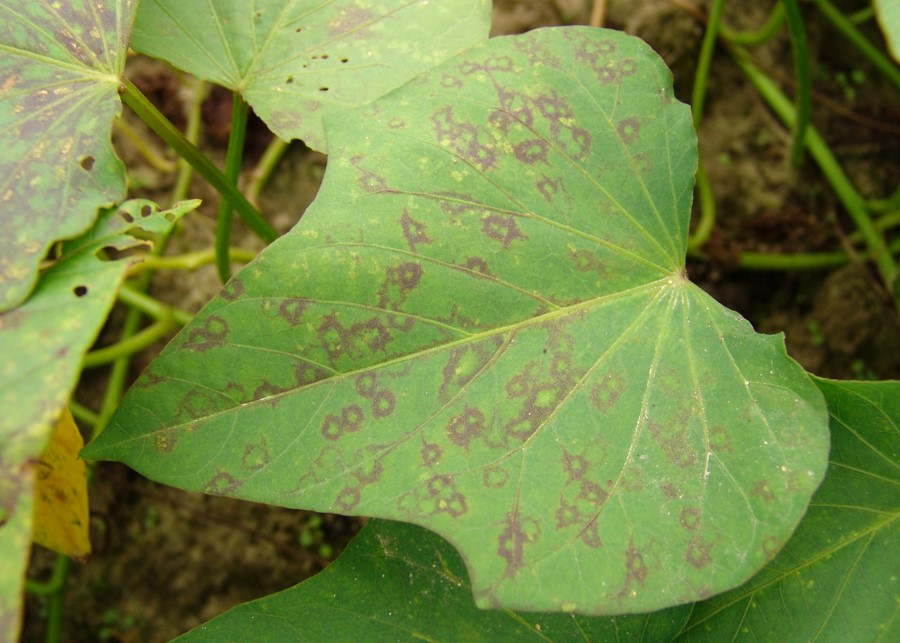Understanding the structure of viruses to develop strategies against plant diseases
- Details
- Category: Projects
-
26 Jun 2023
Sweet potato feathery mottle virus and sweet potato mild mottle virus cause huge losses in sweet potato crops, especially in African and Latin American countries, where this species is a staple crop. Scientists at CRAG have contributed to solve the structure of these viruses. The research aims to explain their mode of infection and open up new strategies for their control.

A team of researchers from CRAG has published a study that describes the characteristic structural properties of two viruses that infect sweet potato, Sweet potato feathery mottle virus (SPFMV) and Sweet potato mild mottle virus (SPMMV). Both belong to the same family Potyviridae, but have different transmission vectors. That is, they are transmitted by different insects: SPFMV is transmitted by aphids, and SPMMV by whiteflies. The characteristic symptoms of infection are dwarfing of the plants and reduction in size, deformation, yellowing and curling of the leaves. Infection by either or both viruses can cause significant crop losses.
One thing that intrigued scientists is why two viruses of the same family have such different and specific transmission vectors, aphids and whiteflies. These insects act as vectors for the plant-to-plant transmission, but little is known about the details leading to their specificity.

The research now released, led by Juan José López-Moya, a CSIC researcher at CRAG, has solved the structure of the capsid proteins of the two viruses and their assembly into virions (the extracellular infectious viral particles, which are used to disseminate in the environment).
One thing that intrigued scientists is why two viruses of the same family have such different and specific transmission vectors, aphids and whiteflies
As Juan José Lopez-Moya explains, they have seen that "the two viruses share a common helical arrangement of their capsid proteins, but have different structural properties and, above all, significantly different stabilities". The whitefly-borne virus, López-Moya adds, is more stable than the aphid virus. The research may help explain why both viruses are specific to each insect vector.
For the research, they have worked with virus-like particles (named VLPs). They have the same outer protein structure as virions but do not contain the internal genetic material (RNA in this case) that is needed to replicate the virus and cause disease in a susceptible plant. "It's like having the same box of biscuits of a certain brand, but without the biscuits inside, or with different biscuits that do not cause the disease," López-Moya illustrates as an analogy to explain what a VLP is. The resolution of the structure has been carried out by cryo-electron microscopy with the collaboration of teams from the John Innes Centre and the University of Leeds (UK).

This research may help to develop new strategies to control viral infections; VLPs could be used as specific molecules to recognize and attach to the virus-insect receptors, blocking them
This research effort may help to develop new strategies to control viral infections. VLPs could be used as specific molecules to recognize and attach to the virus-insect receptors, blocking them and therefore preventing the viruses from being "picked up and transported" by the insects, which would stop disease transmission. “It's like having a competing molecule that allows you to prevent that transmission”, the scientist points out.
"It's still early to imagine how that could be applied to large crop fields, but we're planning to adress that for the future," López-Moya acknowledges. "What currently works best against viruses is to be able to grow a cultivar or plant variety resistant to the disease, but this is not always possible, so we are looking for other ways to stop infections".
CRAG's Plant Viruses group brings together scientists from CSIC and IRTA who are researching to develop tools to control plant pathogenic viruses by interfering with transmission processes and using genetic resistance. In addition to the mentioned sweet potato viruses, they are also working on cucumber mosaic virus and different tomato viruses.
Reference:
Chase, O., Javed, A., Byrne, M.J. et al. CryoEM and stability analysis of virus-like particles of potyvirus and ipomovirus infecting a common host. Commun Biol 6, 433 (2023). https://doi.org/10.1038/s42003-023-04799-x




